

Table of contents
- Flowers for shady and semi-shady places
- Flowers that love sunny places
- flowers for spring
- Flowers that bloom in summer
- autumn flowers
- Flowers that bloom as houseplants in winter
- Flowers for a natural flower meadow or a pond bank
Flowers are the most important design elements for gardens and balconies. They give joy with their colorful flowers almost all year round. In the lexicon of the 50 types of flowers, you can find out which flowers bloom at which time of the year and which flowers are suitable for a natural-looking flower meadow or for a pond bank. You will also find information about types of flowers that thrive in the shade and an overview of the flowers that need a lot of sun to bloom in a colorful way.
Flowers for shady and semi-shady places
cyclamen(cyclamen)
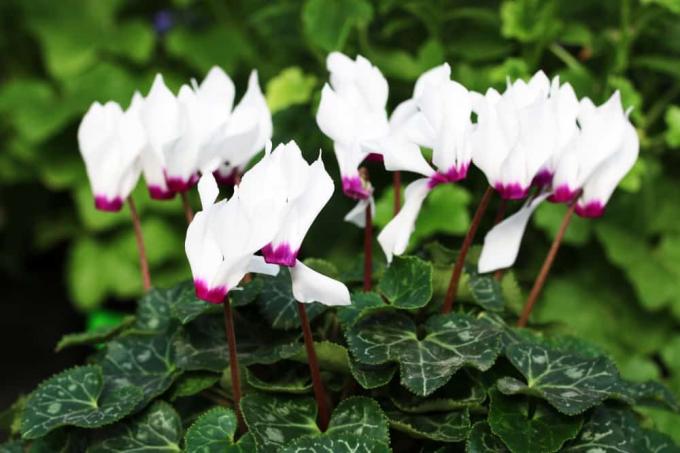
- Origin: mountainous forest regions of the eastern Mediterranean
- Location: bright but not sunny, outdoors in the semi-shade in summer, optimal room temperature in the winter at 15 °C.
- Propagation: possible from seeds at any time of the year
- Growth: strong herbaceous leaves in dark green often with light green shading. Flowers in white, red, pink, salmon pink or purple.
- Flowering time: September to April
Anemone, wood anemone(Anemone nemorosa)
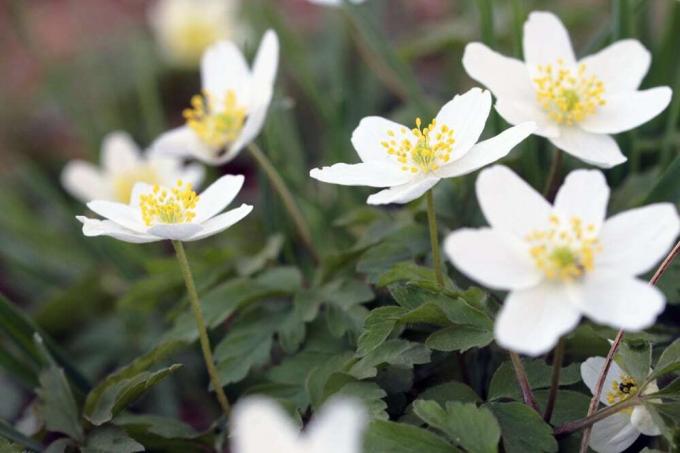
- Origin: Europe, from deciduous forests
- Location: semi-shady to shady
- Propagation: by seeds, by dividing the rhizomes
- Habit: Herbaceous, upright, covering the ground, dark green pinnate leaves, six-petalled, star-shaped, white flowers
- Flowering time: March to April
Busy Lizzie(Impatiens walleriana)
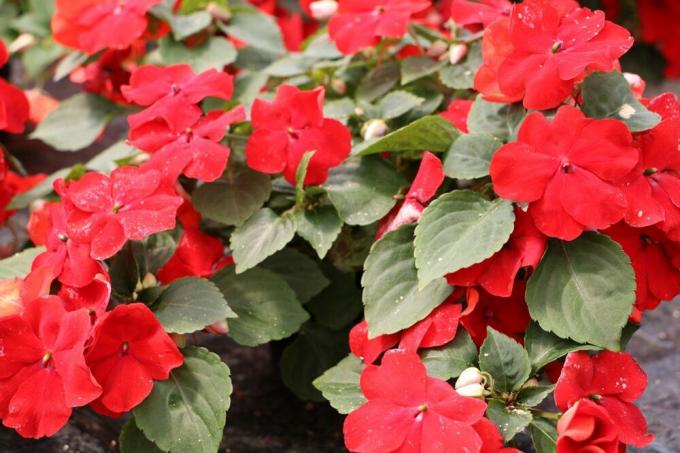
- Origin: Sri Lanka, tropical East Africa, India, New Guinea
- Location: light to semi-shade, keep cooler in darker locations (12 to 15 °C)
- Propagation: Very easily by cuttings from the head, in spring also by seeds
- Growth: ampelous, creeping, elliptical leaves, numerous flowers in colors such as white, soft pink, salmon pink, orange, purple, scarlet or white and red stripes
- Flowering time: summer and autumn, depending on the variety also all year round
Cuckoo Flower, Creeping Bugle(Ajuga reptans)
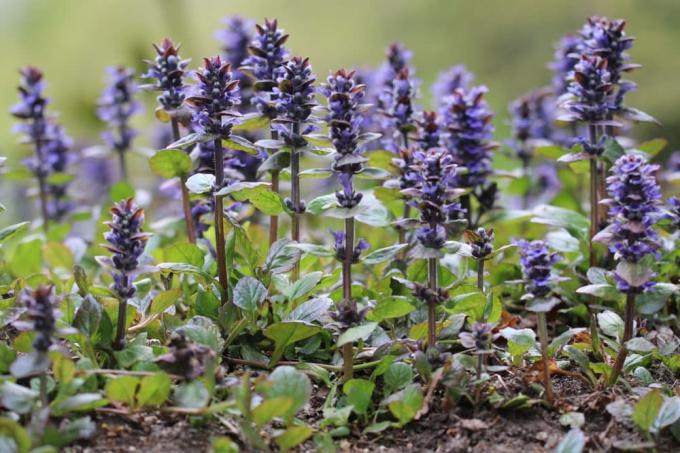
- Origin: Europe, Near East
- Location: semi-shady, shady, off-sun and alternating sun
- Propagation: stolons and seeds
- Habit: herbaceous, ground-covering, about 10 cm high, green or purple foliage, spike-shaped, violet-blue flower spikes
- Flowering period: May to June
lily of the valley(Convallaria majalis)
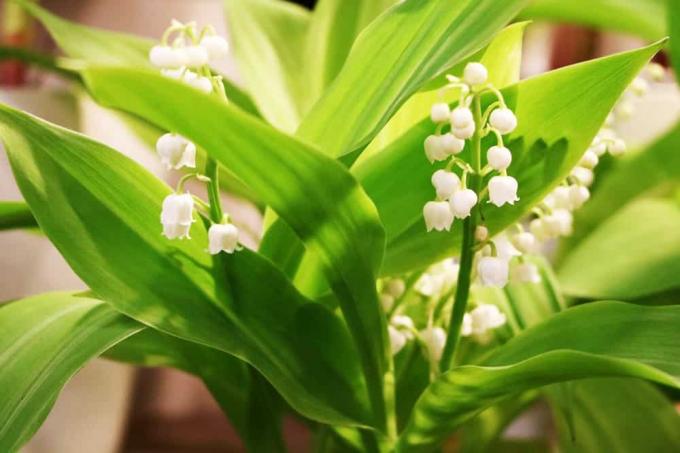
- Origin: European and Asian forests
- Location: partial shade and shade
- Propagation: by dividing the rhizomes, flowering germs, stolons
- Growth: about 10 cm high, two to three leaves per plant, white flowers with broad bells
- Flowering time: May
crying heart(Lamprocapnos spectabilis)
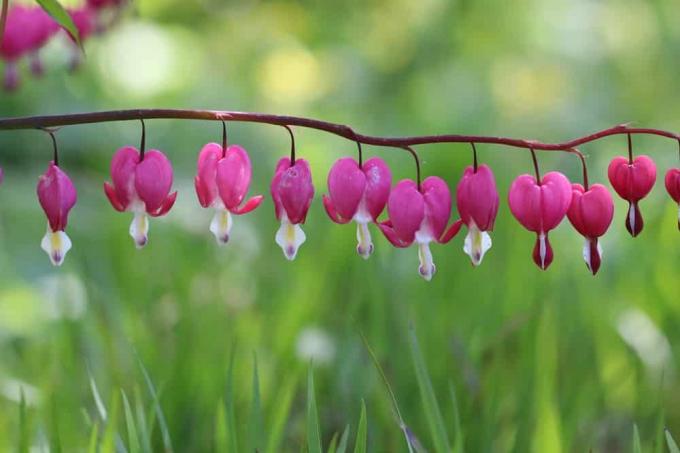
- Origin: North America, Northeast Asia
- Location: partially shaded
- Propagation: Division, cuttings, seeds (cold germs)
- Growth: shrubs with delicate herbs and clusters of hanging flowers, pink hearts with white tips
- Flowering period: from May to August
- Tip: Cutting instructions for Bleeding Heart
violet(Viola)
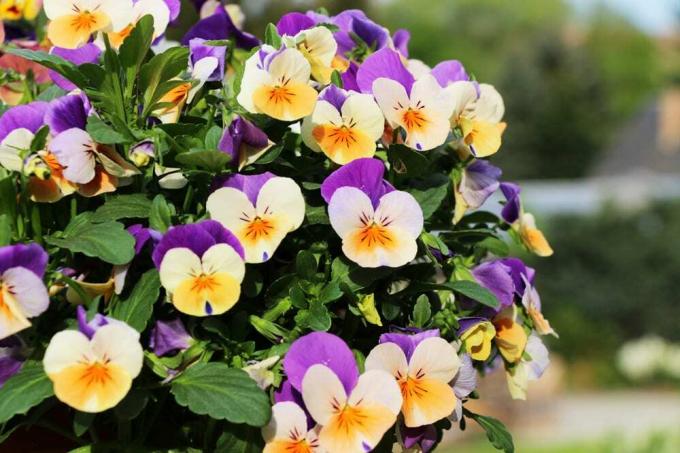
- Origin: North America, Peru, Japan, Australia, Tasmania
- Location: partially shaded
- Propagation: seeds
- Growth: upright, kidney-shaped to heart-shaped leaves, violet-blue flowers, nodding
- Flowering time: April to June
- Overwintering: horned violets tolerate more cold than other violets
Flowers that love sunny places
edelweiss(Leontopodium)

- Origin: Mountains of Europe and Asia
- Location: steppe-like alpine meadows in a sunny south-facing position
- Propagation: by seeds in March and by division
- Habit: Compact, clumpy, herbaceous perennials, relatively flat on the ground, up to 20 cm high, lanceolate leaves, hairy, star-shaped tubular flowers in silvery white
- Flowering period: June to September
freesia (freesia)
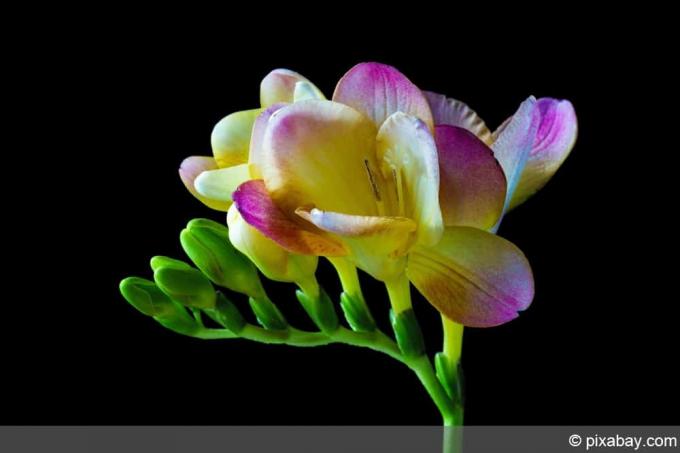
- Origin: South Africa
- Location: sunny
- Propagation of Freesia: by division in spring and autumn
- Growth: upright, approx. 10 cm tall, sickle-shaped leaves, double flowers in white, pink, yellow, lime green and purple
- Flowering time: until September
geranium(Pelargonium)
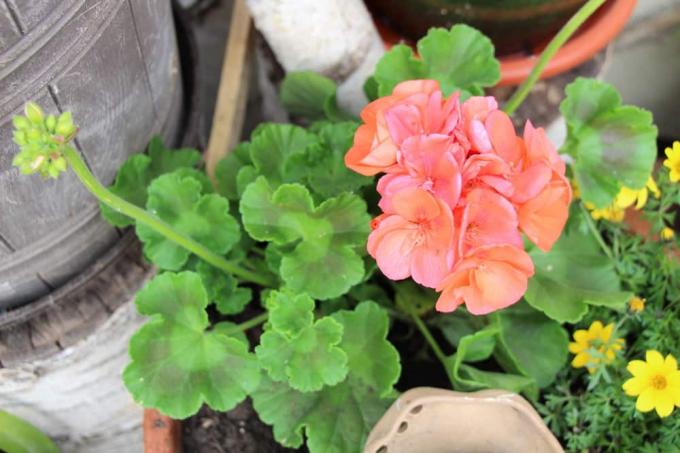
- Origin: South Africa
- Location: sunny, protected from rain, on nutrient-rich soil
- Propagation: seeds, cuttings or division
- Habit: hanging or upright, herbaceous leaves, umbellate flowers in red, pink, salmon and white
- Flowering time: from May to late autumn
- Care instructions for noble geraniums (Pelargonium grandiflorum)
gerberas(Gerbera jamesonii)
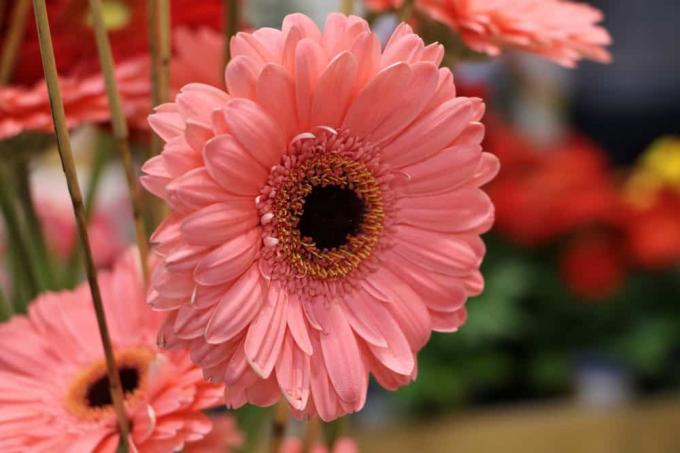
- Origin: Asia, southern Africa
- Location: sunny, loose, sandy soil
- Propagation: seeds
- Habit: Tongue-shaped, dark green, serrated leaves, long-stemmed, radiating daisy flowers in white, yellow, salmon, pink and dark red
- Flowering period: April to September
- Care instructions for potted gerberas
gladiolus(gladiolus)

- Origin: Southern Europe, Africa
- Location: sunny in loose, moist, nutrient-rich soil, sheltered from the wind
- Propagation: bulbs (tubers)
- Growth: up to 2 meters high, upright, lanceolate leaves, spike-shaped inflorescences in bright colors such as salmon and red, but also in white
- Flowering period: June/July to September
Poppy(papaver)
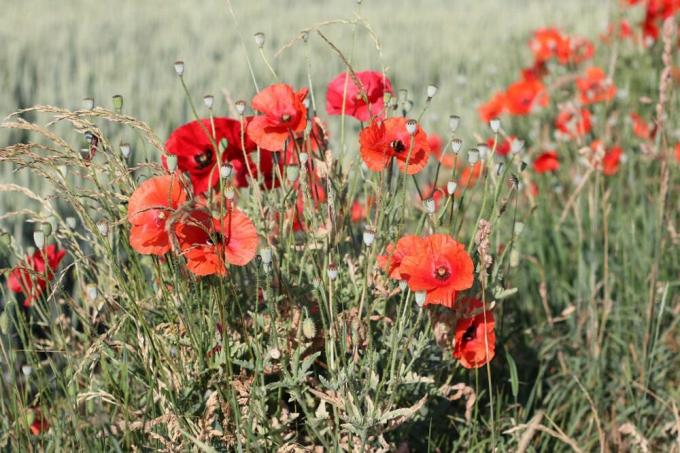
- Origin: Orient, Asia Minor, Caucasus
- Location: sunny to full sun
- Propagation: seeds
- Habit: upright, 60 to 90 cm high, plum-shaped, pink to crimson flowers
- Flowering period: June to August
- Species: Turkish poppy, opium poppy, icelandic poppy
tulip(Tulipa gesneriana)
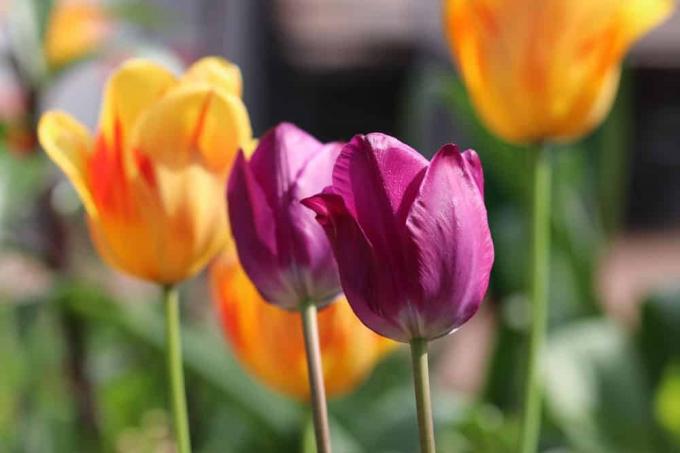
- Origin: Persia
- Location: sunny
- propagation: Tulip Bulbs
- Habit: Standing alone on stalks, broadly cupped petals in yellow, white, pink, violet, mottled or black
- Flowering period: early April to late May
flowers for spring
Clematis, clematis(Clematis vitalba)
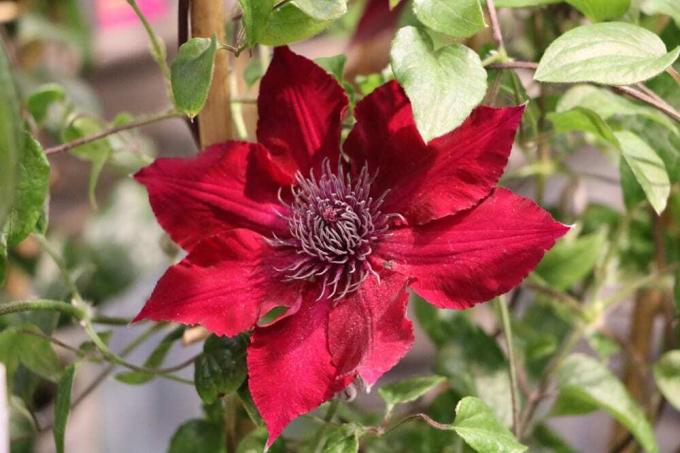
- Origin: China, North America
- Location: sunny to slightly semi-shady
- Propagation: offshoots (cuttings)
- Habit: Subshrub, woody, herbaceous climber, alternate, ovate to lanceolate leaves, long, panicked inflorescences in light pink to chimney pink
- Flowering period: May to June
- Wintering: not all clematis are hardy
hyacinth(Hyacinthus)

- Origin: rocky slopes in the Mediterranean and the Orient
- Location: sunny and warm
- Propagation: onions
- Habit: upright, up to 30 cm high, racemose inflorescences with sixfold flowers in colors such as pink, salmon, white, blue, purple and red
- Flowering time: April to May/June
- tips for Hyacinths overwinter
crocus(crocus)
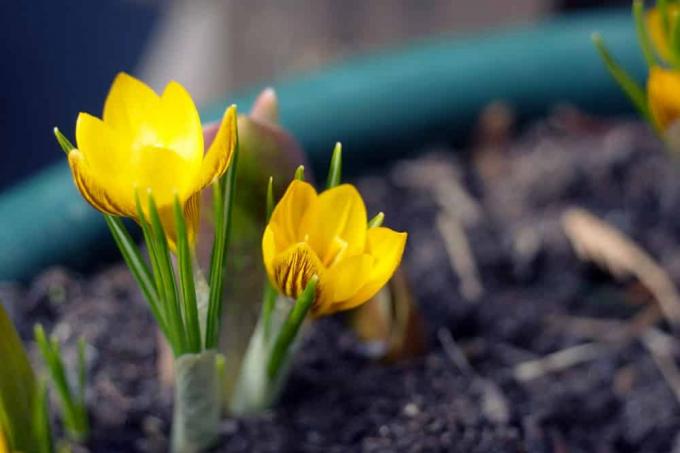
- Origin: Southern Europe, Central Europe, North Africa, Middle East, Western China
- Location: sunny to semi-shady
- Propagation: stem tuber
- Growth: about 5 cm high, grass-like leaves with parallel nerves, cup-shaped flowers in purple, yellow and white
- Flowering time: February to March
- Care instructions for crocuses
daffodil(narcissus)
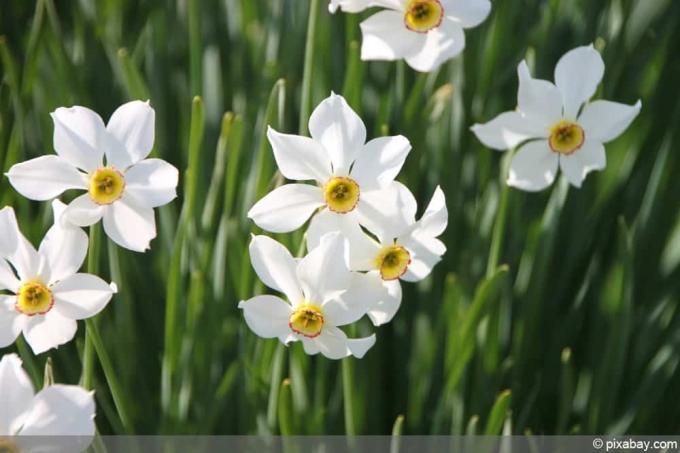
- Origin: Southwest Europe, Northwest Africa
- Location: sunny to semi-sunny
- Propagation: onions
- Growth: up to 80 cm high, elongated, smooth-edged leaves, white to light yellow, trumpet-like flowers, often with orange edges
- Flowering time: March, April
- Care instructions daffodils
daffodil (Narcissus pseudonarcissus)
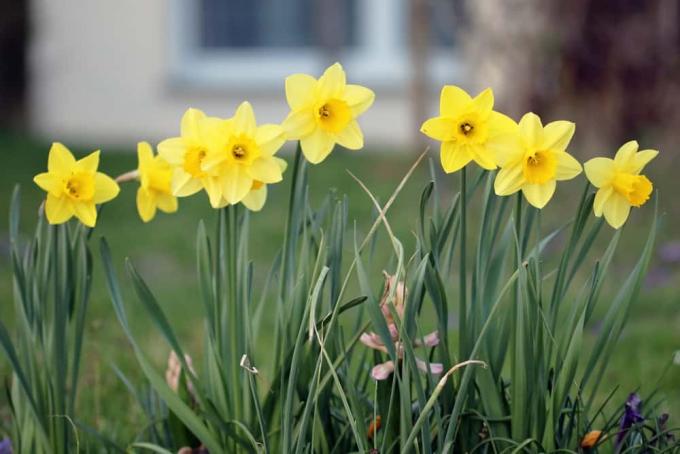
- Origin: Central Europe, North Africa
- Location: sunny
- Propagation: onions
- Habit: upright, up to 40 cm high, lanceolate, smooth-edged leaves, bright yellow, funnel-shaped flowers with a tube of six fused petals
- Flowering time: March to April
cowslip (Primula veris)
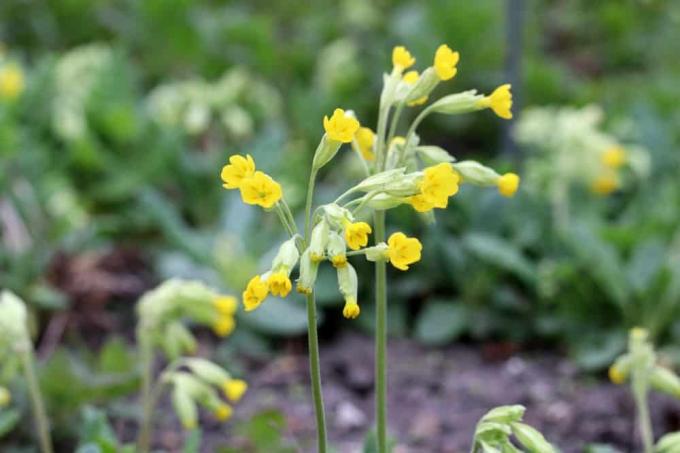
- Origin: Europe, Asia
- Location: sunny to semi-shady
- Propagation: by seeds and by division in spring and autumn
- Habit: upright, clump-forming, about 20 cm high, oval, medium-green leaves with serrated edges, five-petalled, golden-yellow flowers
- Flowering time: March/April to May/June
- Cautious: Cowslips are poisonous
snowdrop (Galanthus)
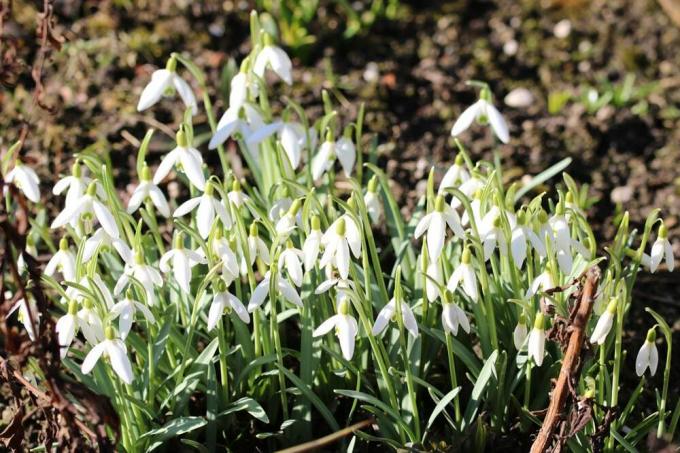
- Origin: from humid forests in western, central and southern Europe
- Location: full sun, lots of light, humus-rich, loose soil
- Propagation: distribution of seeds by ants, division of clumps, planting of daughter bulbs
- Habit: Narrow, leathery leaves, white, drooping, bell-shaped flowers with three long outer petals and three short inner petals tipped with green
- Flowering period: January to March
- Caring for snowdrops
Flowers that bloom in summer
gloxinia (sinningia)
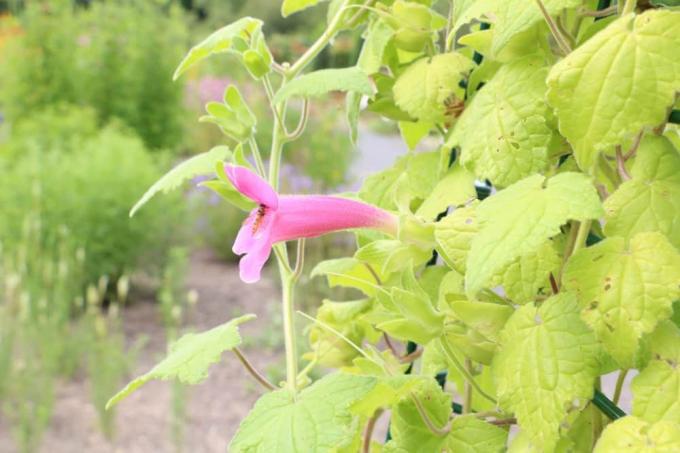
- Origin: Brazil
- Location: warm, humid, bright but not sunny
- Propagation: from seeds, artificial light necessary from November to February
- Habit: dark green oval leaves, large, funnel-shaped, nodding flowers in white, violet, red, pink and lilac
- Flowering time: March to August
lily (Lilium)

- Origin: Asia, Northern Europe
- Location: sunny to semi-shady
- Propagation: onions
- Growth: between 30 centimeters and 3 meters high, smooth stems with sessile, smooth-edged, elongated leaves, racemes arranged trumpet-shaped flowers in colors like white, yellow, pink or salmon. They are often mottled with dark dots.
- Flowering period: from May to September
- Tips for overwintering lilies
clove (dianthus)

- Origin: Europe, Asia
- Location: permeable, nutrient-rich soil
- Propagation: by seeds and by division in spring and autumn
- Habit: straight, cushion-forming, up to 50 cm tall, narrow, lanceolate, bluish-green leaves, double flowers in pink, white, green and red with jagged edges
- Flowering period: June to August
- Care instructions for carnations
delphinium (Delphinium)
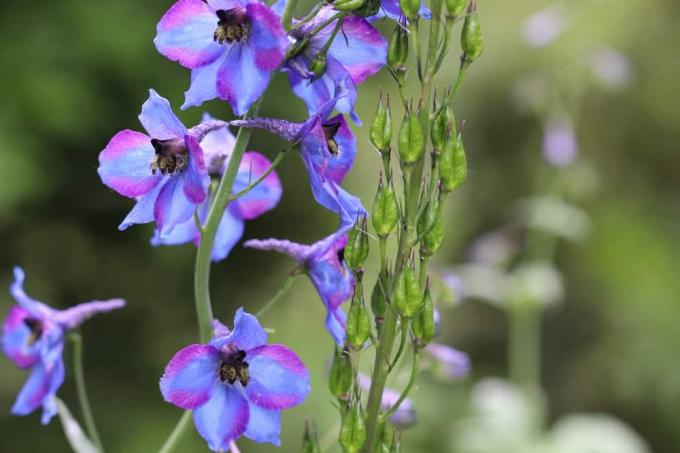
- Origin: Eurasia, America, Africa
- Site: sunny, shaded at the foot, sheltered from the wind on loamy, sandy, humus-rich soil
- Propagation: uncontrolled by self-sowing, leaving two flower stalks
- Growth: taut, upright, clump-forming, approx. 1.50 m tall, finger-shaped, pointed-lobed leaves, racemose, violet-blue flowers with a long spur
- Flowering time: June to August/September
- Care Instructions for Larkspur
rose (Pink)
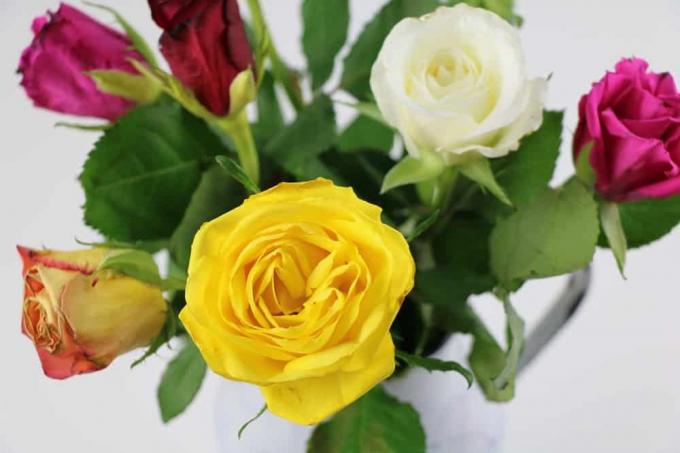
- Origin: China, Persia
- Location: very bright to sunny
- Propagation: cuttings, seeds, grafting
- Habit: shrubby, upright, upright or creeping, heart-shaped, threefold leaves, thorns, double rosette flowers in colors such as velvet red, yellow, orange, salmon, black, purple, pink and white
- Flowering time: summer and autumn
- Tip: Mix rose soil yourself
pansies (Viola tricolor)
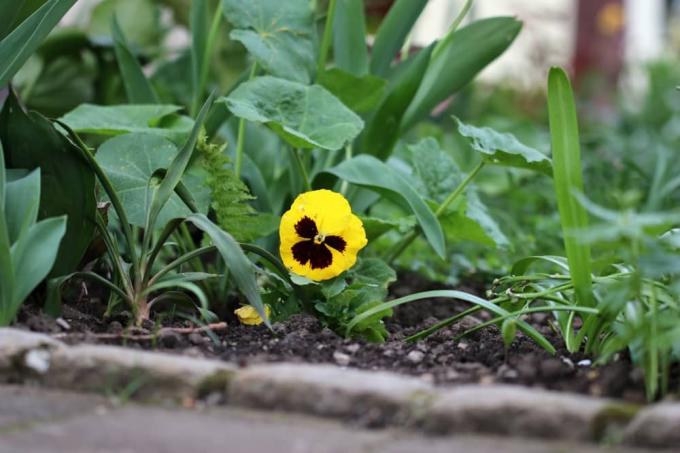
- Origin: Europe
- Location: sunny
- Propagation: seeds
- Habit: Spurred leaves, small flowers of 4 to 6 cm with five petals in bright colors such as dark blue, violet or yellow
- Flowering time: April to October
- Tip: Care instructions for pansies
vetch (Vicia)
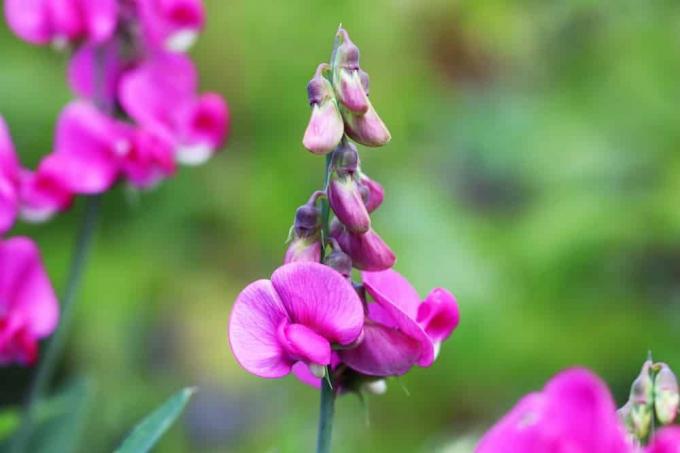
- Origin: northern temperate areas, South American Andes
- Location: sunny to semi-shady
- Propagation: seeds from pods
- Habit: Climbing, pinnate leaves, fivefold butterfly flowers in colors such as red, white, light purple and dark purple
- Flowering period: June to September
- Tip: Care tips for sweet peas
autumn flowers
aster (Asteraceae)

- Origin: Eurosia, Africa, America
- Location: sunny, semi-shady
- Propagation: division and replanting
- Habit: mostly yellow tubular flowers, cup-shaped inflorescences on the stems, petals arranged in a radial pattern
- Flowering time: autumn
- Tip: Care instructions for asters
chrysanthemum (Chrysanthemum)

- Origin: China and Japan
- Location: bright and cool
- Propagation: by cuttings in spring
- Growth: long-stemmed, dark green, pinnate leaves, large, full tubular flowers in lemon yellow, golden yellow, reddish brown, pink, wine red and light violet
- Flowering time: originally July to December, through breeding all year round
- Tip for further reading: Overwinter chrysanthemums
dahlia (Dahlia)
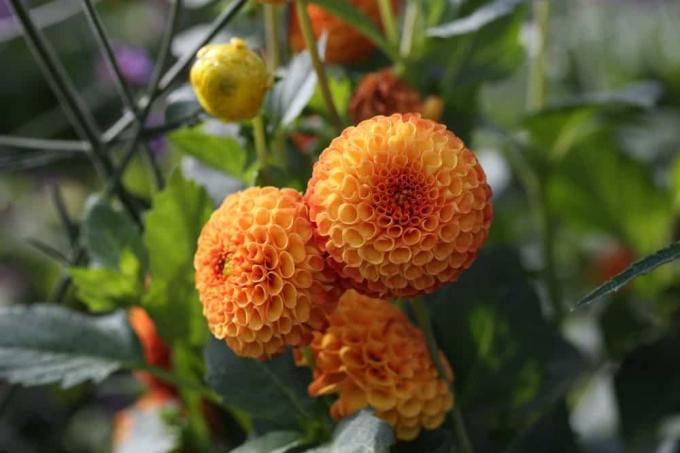
- Origin: Mexico
- Location: sunny and warm on nutrient-rich soil
- Propagation: by cuttings and division of the tubers
- Habit: daisy family, about 50 cm high, tubular flowers in white, yellow, red, orange, salmon, pink, purple, lilac or multicolored
- Flowering period: from May/June to October/November
- Hibernation: tips to to overwinter dahlias
fuchsia (fuchsia)
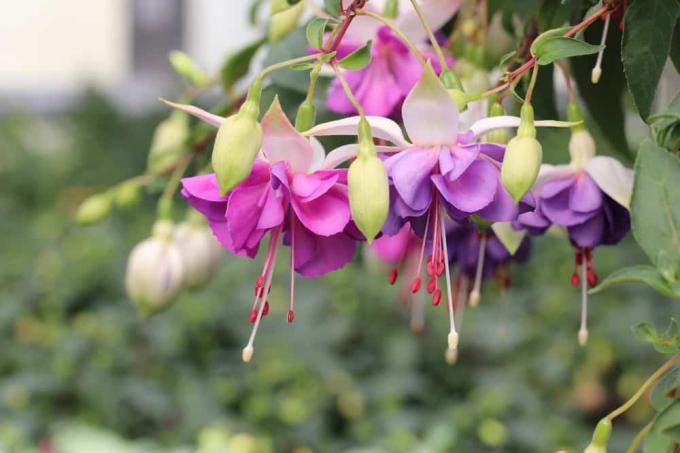
- Origin: Mountain forests of Central and South America, some species come from Tahiti and New Zealand
- Location: Shade, partial shade and sun
- Propagation: cuttings from shoot tips
- Habit: hanging, bushy oval leaves, delicate bell-shaped flowers in pink-white or blue-violet
- Flowering time: with mild temperatures from June to December
- For further reading: Care instructions for fuchsias
petunia (Petunia)
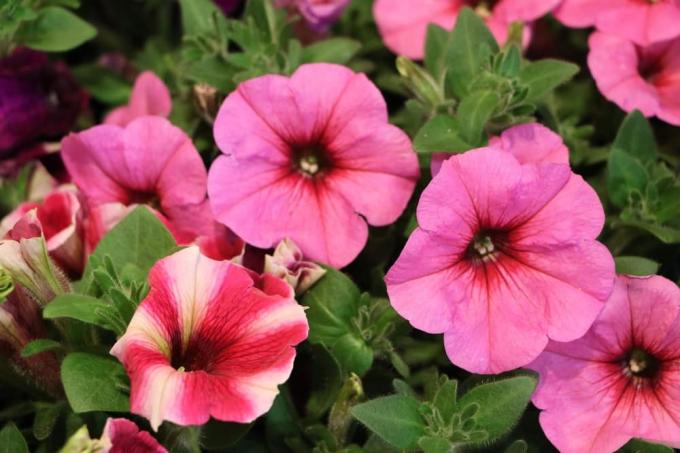
- Origin: tropical South America
- Location: sun and partial shade
- Propagation: by seeds
- Habit: Hanging, ampelous, dark green, entire, slightly hairy leaves, trumpet-shaped flowers in white, pink, violet, red or blue, as well as star-shaped or striped
- Flowering period: from May to October
- For further reading: Successfully wintering petunias
marigold (Calendula officinalis)
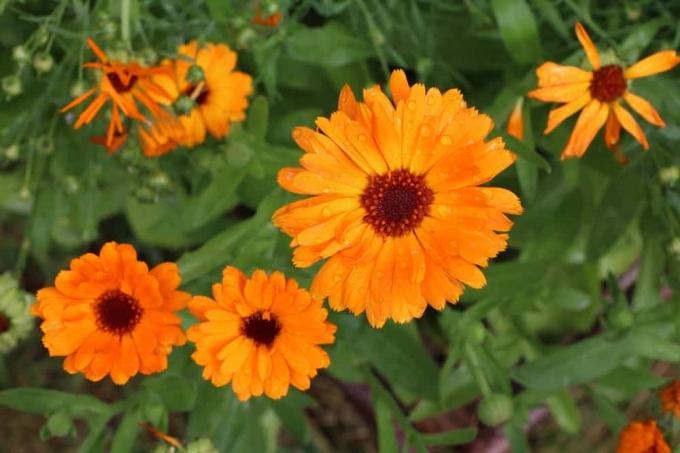
- Origin: Mediterranean
- Location: sunny to shady, sandy and loamy soil
- Propagation: by seeds
- Habit: lanceolate sessile leaves, wheel-shaped flower heads in yellow and orange
- Flowering period: June to October
- for further reading: Care instructions marigold
Flowers that bloom as houseplants in winter
azalea (Rhododendron)

- Origin: Central China, Japan mountainous regions
- Azalea location: bright location without direct sunlight, as cool as possible from 8 to 16 °C
- Propagation: by cuttings in early spring
- Habit: Shrubby plant, tall stems, elliptical, shiny green leaves, rosette-shaped small flowers in white, red, pink and violet
- Flowering period: October to April
begonia (begonias)
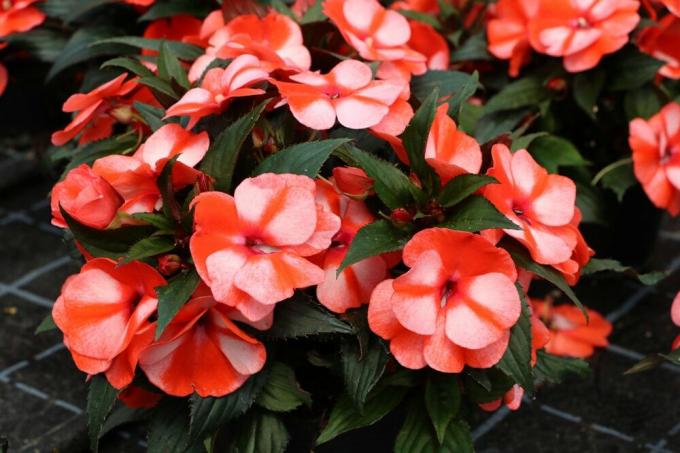
- Origin: tropical rainforests of South America, Asia, Africa
- location for begonias: bright but not in direct sunlight, ambient temperature should not fall below 18 °C
- Propagation: by cuttings in April and May
- Habit: thick fleshy, heart-shaped leaves, ball-shaped, double and single flowers in yellow, pink, red and white
- Flowering period: January to December
orchid (Orchidaceae)
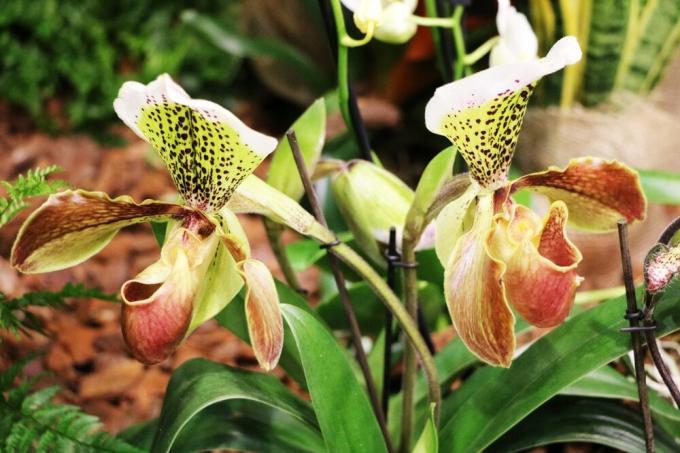
- Origin: tropical Asia, Philippines, Australia, South America, Indonesia
- Location: bright to semi-shady
- Orchid Propagation: by dividing when repotting
- Habit: long-stalked, long, narrow leaves, lip-shaped and butterfly-shaped flowers in pink, green, rust, yellow or purple, often with two-tone stripes, mottled or mackerel
- Flowering time: depending on the species in spring, summer, autumn and winter
slipper flower (Calceolaria)
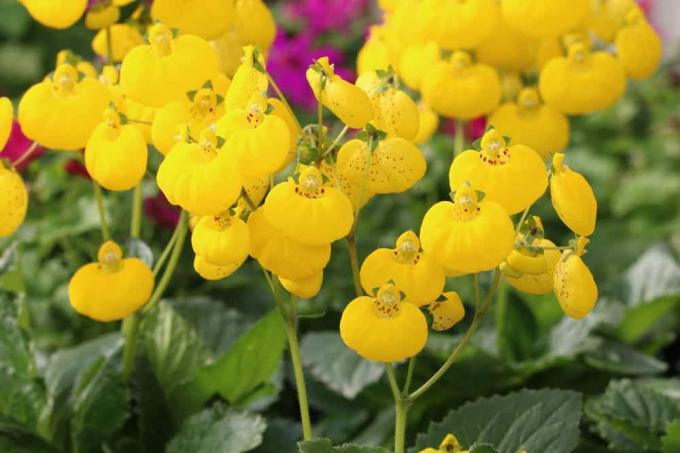
- Origin: South America
- Location: very bright, but not in full sun, as cool as possible (15 to 20 °C)
- Propagation: by seeds in summer germination temperature 18 °C
- Habit: Shrub with oval to plate-shaped leaves, flowers with a wide lower lip in yellow, red and orange, unicolored, bicolored or mackerel
- Flowering period: January to May
- Tip for further reading: Care of slipper flowers
primrose (Primula)
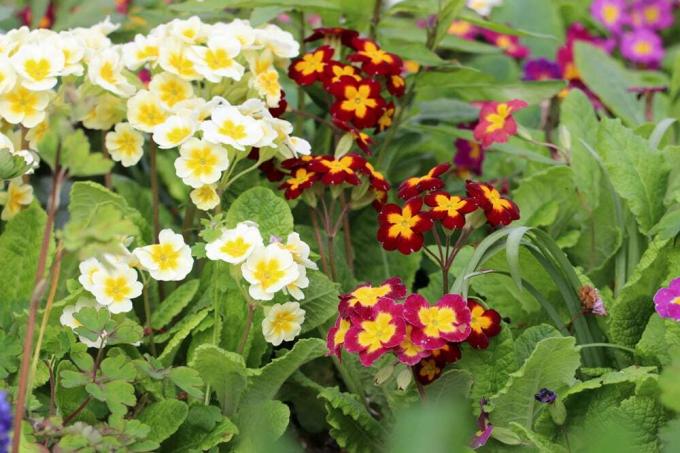
- Origin: western and southern Europe and China
- Location: bright but not sunny, cool 10 to 15 °C during flowering
- Propagation: by seeds
- Habit: Round to oval leaves, single five-petalled flower clusters in dark red, purple, yellow, orange or white, often yellow in the centre
- Flowering season: winter and spring
- Tip: Care instructions for primroses
African violets (Saintpaulia ionantha)
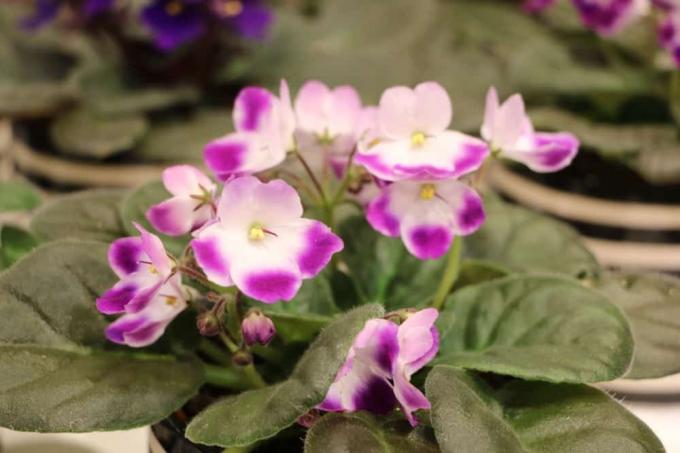
- Origin: Tanzania
- Location: bright to semi-shady, no sun, 20 °C and above in summer, not below 18 °C in winter
- Propagation: by leaf cuttings at soil temperatures above 20 °C
- Habit: heart-shaped leaves, flowers in shades of blue, violet, pink and red
- Flowering period: from January to December, depending on the age of the plant, forms new flowers several times in a row, interrupted by periods of rest lasting several weeks
- Tip: Caring for African violets properly
Flowers for a natural flower meadow or a pond bank
daisy (Bellis perennis)
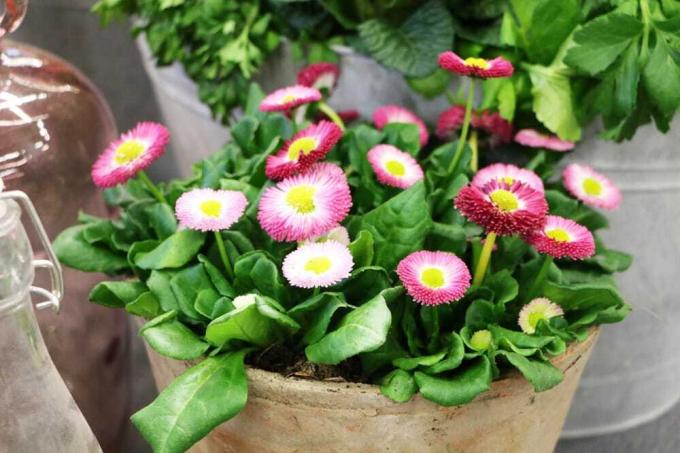
- Origin: Mediterranean region, widespread in Central and Northern Europe
- Location: sunny
- Propagation: seeds, root division
- Habit: upright, about 5 cm high, rosette-shaped leaves, small white radiating basket-like flowers, yellow in the centre
- Flowering time: March to November
- for further reading: Caring for blue daisies
bluebell (campanula)
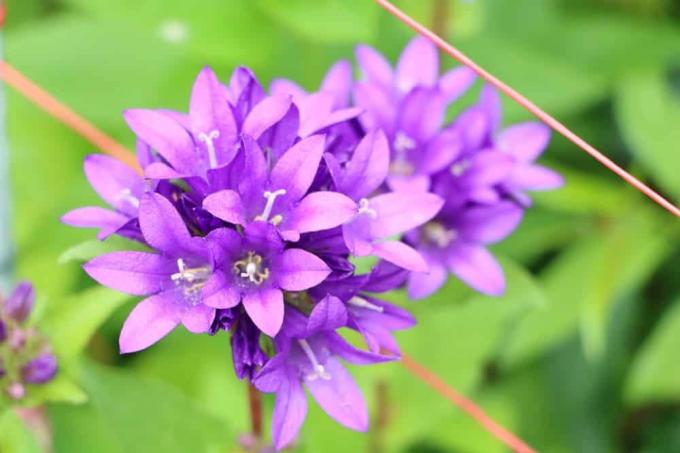
- Origin: Mediterranean
- Location: bright to sunny, protect from the blazing midday sun in summer
- Propagation: place cuttings in a peat-sand mixture
- Habit: dark green, heart-shaped leaves, blue-violet or white bell-shaped flowers
- Flowering time: March to October
- to read further: Bellflower: care from A to Z
cornflower (Centaurea cyanus)

- Origin: Southern Europe
- Location: warm, full sun, dry, lime-poor soil
- Propagation: seeds
- Habit: Stiff stems with downy hairs, elongated, lanceolate leaves, cup-shaped inflorescences with bright blue tubular flowers
- Flowering period: from May to October
snapdragon (antirrhinum)
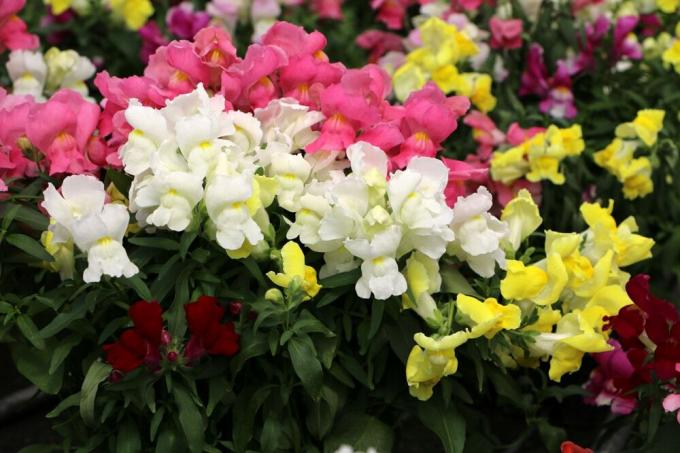
- Origin: dry Mediterranean zones
- Location: sunny and partially shaded on sandy and loamy soil
- Propagation: by seeds
- Habit: herbaceous, between 20 and 100 cm high, elliptical leaves, spike-shaped flower panicles in yellow, orange, red, pink, white and multicolored
- Flowering period: June to September
- tips for Snapdragons hibernate
lupine (lupinus)
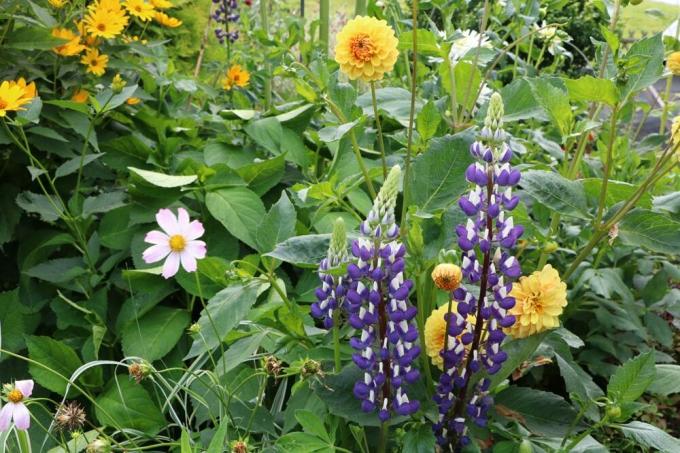
- Origin: North America
- Location: sunny, semi-shady
- Propagation: seeds
- Habit: Patricians, upright, up to 1.50 meters high, fan-shaped, fingered leaves, up to 50 cm long, racemose inflorescence with 50 to 80 flowers in colors such as pink, purple, salmon, light blue or White
- Flowering period: late May to early August
daisy (leucanthemum)
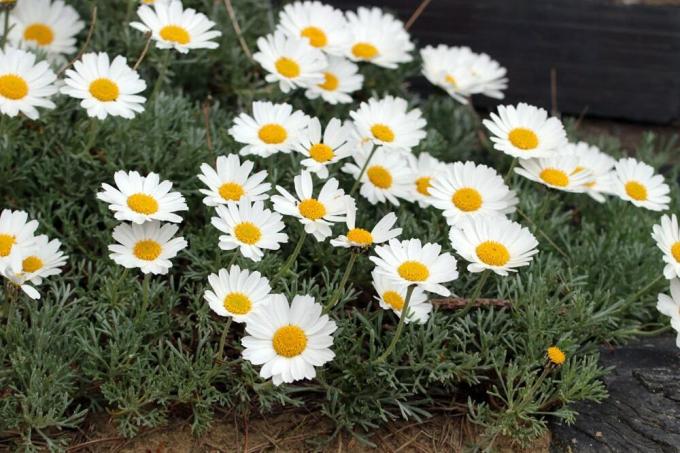
- Origin: Europe
- Location: sheltered from the wind and sunny
- Propagation: cuttings and seeds
- Habit: upright, upright or bushy, up to 60 cm tall, leaves alternate on the stem, large white, radial basket-like flowers up to 6 cm in diameter, yellow in the middle
- Flowering period: May to July
- Tip for further reading: Overwinter daisies
marsh marigold (Caltha palustris)
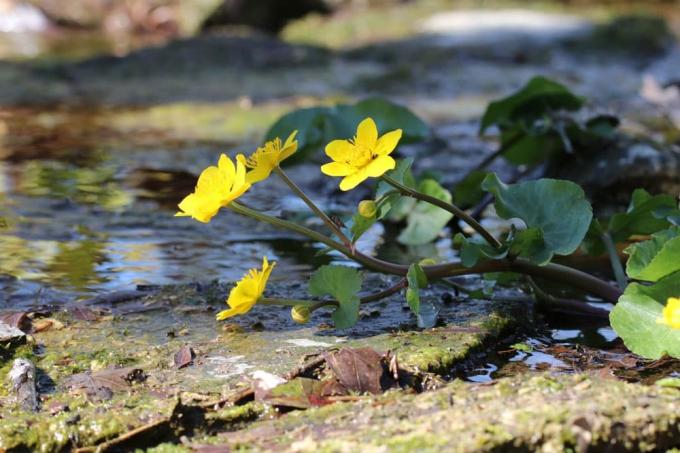
- Origin: Central Europe, Northern Europe, Northern Asia, Arctic North America, Iceland
- Location: sunny, moist, near ponds, marshy meadows and watercourses
- Propagation: seeds
- Growth: Herbaceous plant with long-stemmed, basal, dark green leaves and golden-yellow flowers
- Flowering time: March to June, weaker second flowering possible from July to October
- for further reading: Marsh marigold care
forget Me Not (myosotis)

- Origin: Europe, Northwest Africa
- Location: Partial shade, moist soil
- Habit: lanceolate leaves, bright sky-blue flowers in fives, arranged in whorls
- Flowering time: March to June
- Tip for further reading: Care instructions for forget-me-nots
Wood Sorrel (Oxalis acetosella)
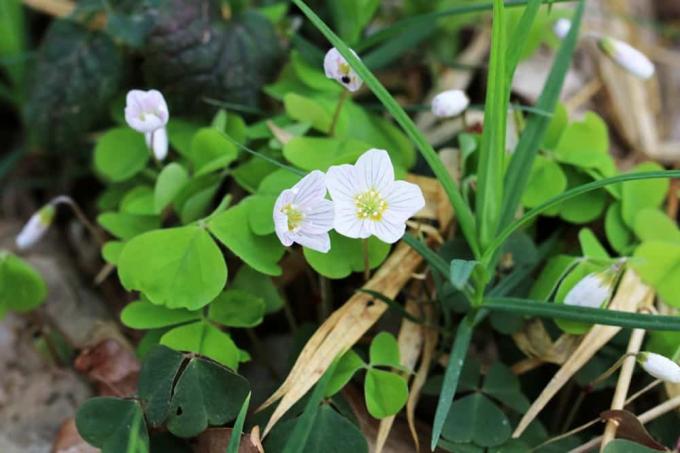
- Origin: Europe, Siberia, Japan
- Site: Shade, sandy, well-drained soil
- Propagation: by division in spring and autumn and by seeds
- Growth: flat, 5 to 8 cm high, three- and four-part leaves with entire margins, white flowers
- Flowering period: from April to May
 Home editorial office
Home editorial office
Find out more about B for hardware store

Plastic bed edging: the advantages and disadvantages of the bed border
In a well-kept garden, the bed edging provides the right framework for the creative planting plan. When selecting suitable materials, plastic is one of the many options. This guide offers a decision-making aid with fundamental pros and cons. Read about the advantages and disadvantages of a plastic border here.

Bed edging made of wood: bed border in the vegetable bed | 5 ideas
Wood is the perfect material for edging the vegetable patch. Close to nature, durable, timeless and in warm colors are just a few of the convincing properties. Be inspired by these 5 ideas on how to create imaginative wooden frames for your beds in the kitchen garden.

Bed edging made of stone: which stones for the bed border?
Can't decide which stones will stylishly accentuate the border of the bed? This guide takes you into the exciting world of diverse types of stone for tasteful bordering. You can find out here which stone gives your garden beds the right frame.
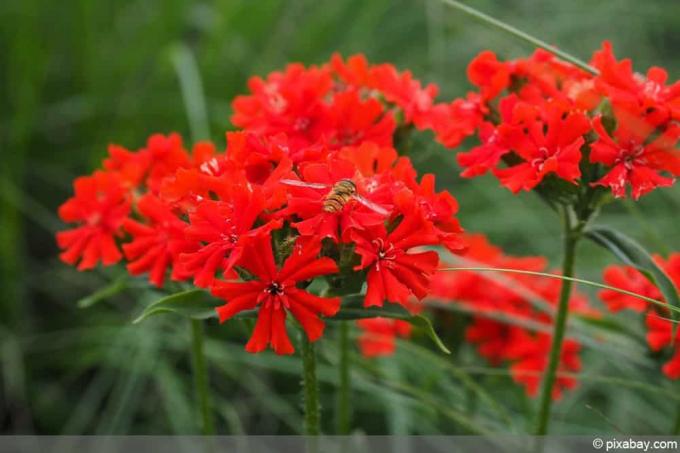
Burning Love, Lychnis Chalcedonica - Care Guide
Boasting bright red flowers perched on taut stems, she lives up to her name. The impressive summer perennial Burning Love is frugal and undemanding at the same time. To ensure that a Lychnis chalcedonica thrives in beds and tubs, these care instructions explain all the relevant details in a compact and understandable way.

Bergenien, Bergenia - varieties and care instructions
As ornamental foliage plants, evergreen bergenias beautify the wintry garden and, as early bloomers, herald the approaching spring with decorative cup-shaped blossoms. Explore a selection of magnificent varieties here, some of which bloom twice a year and are also wonderfully suitable for vase decoration. Our care instructions explain practically how the undemanding Bergenia should be cultivated.

Henbane, Hyoscyamus niger - Care of the plants
There are plants that amaze us, and the black henbane Hyoscyamus niger is definitely one of them. It used to amaze witches with healing powers, but is now considered "too poisonous to heal". Today it amazes gardeners with strong growth that is easy to care for and garden aesthetes with its shape and colour; That's a lot for a single plant.
